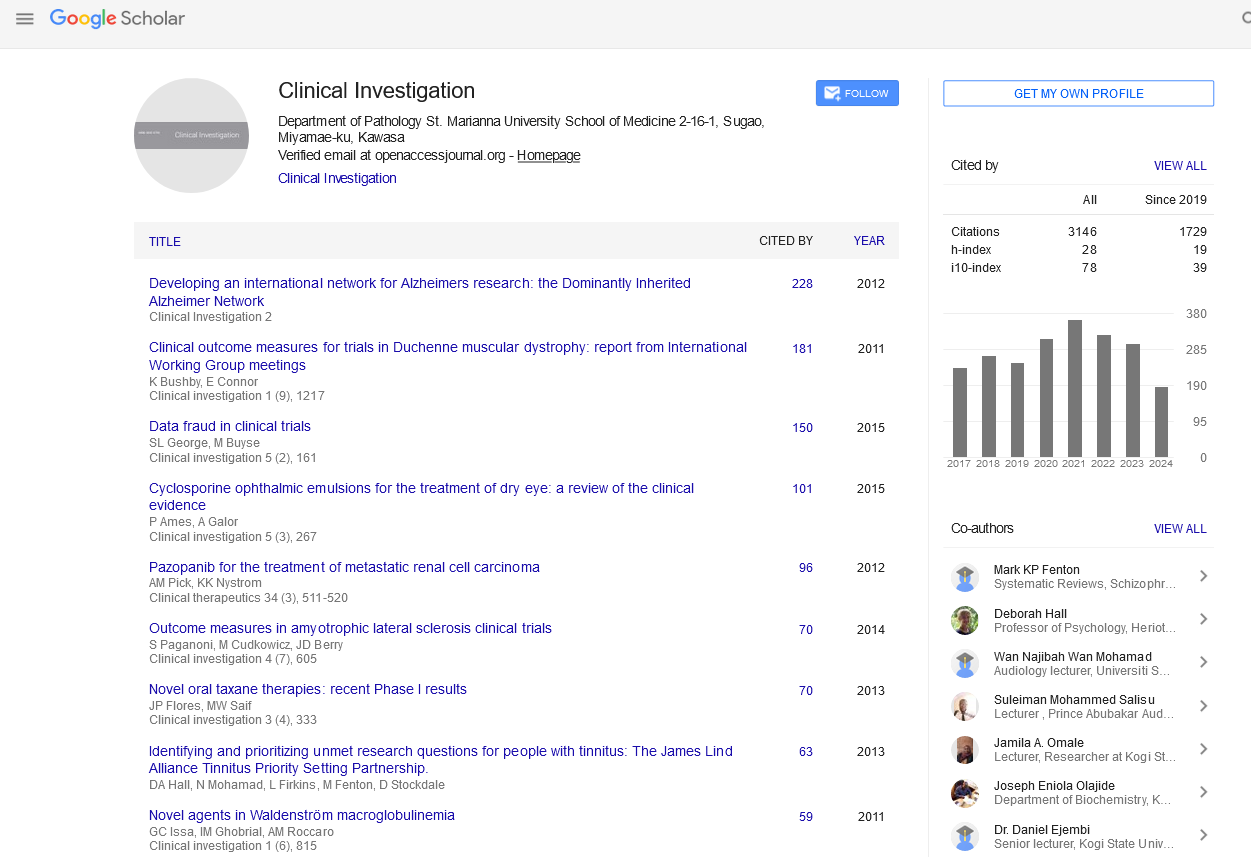Perspective - Clinical Investigation (2024) Volume 14, Issue 4
Autoimmunity: Mechanisms, Implications, and Advances in Treatment
- Corresponding Author:
- Sree Jhu
Faculty of Biology, Daido University, Japan
E-mail: shreejhu@gmail.com
Received: 3-April-2024, Manuscript No. fmci-25-160372; Editor assigned: 5-April-2024, PreQC No fmci-25-160372(PQ); Reviewed: 13-April-2024, QC No. fmci-25-160372; Revised: 22-April-2024, Manuscript No. fmci-25-160372(R); Published: 26-April-2024
Abstract
Autoimmunity refers to a condition where the body's immune system mistakenly attacks its own tissues and organs. This phenomenon occurs when the immune system fails to distinguish between self and non-self, leading to chronic inflammation and tissue damage. The causes of autoimmunity are multifactorial, involving genetic predisposition, environmental triggers, and immune system dysregulation. Autoimmune diseases, such as rheumatoid arthritis, lupus, and multiple sclerosis, are complex, often chronic conditions that can significantly impact an individual's quality of life. This article explores the underlying mechanisms of autoimmunity, the role of genetic and environmental factors, the impact of autoimmune diseases on patients, and recent advances in treatment options. Understanding the pathophysiology of autoimmunity is essential for developing targeted therapies and improving patient outcomes.
Keywords
Autoimmunity • Immune system • Autoimmune diseases • Rheumatoid arthritis • lupus • Multiple sclerosis • Inflammation • Immune dysregulation • Targeted therapies
Introduction
Autoimmunity occurs when the immune system, which typically protects the body from foreign invaders such as viruses and bacteria, mistakenly attacks the body’s own cells and tissues. The immune system is designed to differentiate between "self " and "non-self " entities, but in autoimmune diseases, this distinction is lost. The body produces autoantibodies or immune cells that target its own tissues, leading to inflammation, tissue damage, and dysfunction of the affected organs.
Autoimmune diseases are highly diverse, ranging from conditions that affect only a single organ, such as autoimmune thyroid disease, to systemic diseases that affect multiple organs, such as Systemic Lupus Erythematosus (SLE). The reasons why some individuals develop autoimmune diseases while others do not remain an area of extensive research. The interplay of genetic factors, environmental triggers, and immune system abnormalities is complex and not fully understood.
While autoimmune diseases are not curable, advancements in immunology have led to improved treatments that help manage symptoms, reduce inflammation, and slow disease progression. This article delves into the mechanisms behind autoimmunity, the clinical manifestations of autoimmune diseases, and the latest approaches to treatment and management.
Mechanisms of autoimmunity
The immune system is responsible for defending the body against pathogens, but it must be carefully regulated to prevent it from attacking the body’s own tissues. Autoimmunity arises when this regulation fails, and several mechanisms contribute to its development.
• Loss of self-tolerance: The body’s immune system develops tolerance to its own tissues during a process called central tolerance, which occurs in the thymus and bone marrow. During this process, immune cells (T-cells and B-cells) that recognize self-antigens are eliminated. However, if this tolerance is broken, self-reactive immune cells can escape into circulation and attack normal tissues. This loss of self-tolerance is a fundamental aspect of autoimmunity.
• Molecular mimicry: Molecular mimicry occurs when a pathogen (such as a virus or bacterium) shares structural similarities with human proteins. The immune system, upon recognizing the foreign pathogen, may also attack self-proteins that resemble the pathogen. This mechanism is implicated in conditions such as GuillainBarré syndrome, where the immune system attacks peripheral nerves following a viral infection.
• Environmental triggers: Environmental factors play a crucial role in the development of autoimmune diseases. Infections, drugs, smoking, and other environmental exposures can trigger the onset of autoimmunity in genetically predisposed individuals. For example, infections with Epstein-Barr virus (EBV) have been linked to the development of Multiple Sclerosis (MS) and Systemic Lupus Erythematosus (SLE).
• Genetic factors: Genetics are a key factor in determining susceptibility to autoimmune diseases. Certain gene mutations, particularly those involving the Human Leukocyte Antigen (HLA) system, are associated with a higher risk of autoimmune conditions. HLA molecules are involved in presenting antigens to immune cells. Variations in HLA genes can result in an immune response that targets the body’s own tissues.
• Immune dysregulation: Autoimmune diseases often involve an imbalance in the immune system. In particular, dysregulation of T-helper cells, which coordinate immune responses, can lead to excessive inflammation and tissue damage. In many autoimmune diseases, there is an overproduction of pro-inflammatory cytokines, which amplify the immune response and contribute to chronic inflammation.
Autoimmune diseases: Clinical manifestations and impact
Autoimmune diseases are a group of disorders that vary widely in their symptoms, severity, and the organs they affect. Some diseases primarily affect a single organ, while others have systemic manifestations that impact multiple organs simultaneously.
• Rheumatoid Arthritis (RA): RA is a chronic autoimmune disease characterized by inflammation of the joints, leading to pain, stiffness, swelling, and eventual joint damage. In RA, the immune system attacks the synovium (lining of the joints), causing inflammation and destruction of cartilage and bone. If left untreated, RA can lead to permanent disability.
• Systemic Lupus Erythematosus (SLE): SLE is a systemic autoimmune disease that can affect multiple organs, including the skin, kidneys, heart, and lungs. Common symptoms of SLE include a characteristic butterfly-shaped rash on the face, joint pain, fatigue, and kidney dysfunction. SLE is associated with the production of a variety of autoantibodies, including those against double-stranded DNA.
• Multiple Sclerosis (MS): MS is a central nervous system autoimmune disease in which the immune system attacks the myelin sheath that covers nerve fibers, leading to neurological impairment. Symptoms of MS can vary, but commonly include fatigue, muscle weakness, difficulty walking, vision problems, and cognitive decline. MS is believed to be triggered by a combination of genetic predisposition and environmental factors.
• Type 1 diabetes mellitus: In type 1 diabetes, the immune system attacks the insulin-producing beta cells in the pancreas, leading to insulin deficiency and hyperglycemia. The onset of type 1 diabetes often occurs in childhood or adolescence and requires lifelong insulin therapy to manage blood glucose levels.
• Graves' disease and hashimoto's thyroiditis: Both of these autoimmune thyroid diseases involve the immune system attacking the thyroid gland. In Graves' disease, the immune system stimulates the thyroid to produce excess thyroid hormone, leading to hyperthyroidism. In Hashimoto’s thyroiditis, the immune system destroys thyroid cells, leading to hypothyroidism.
• Celiac disease: Celiac disease is an autoimmune disorder in which the ingestion of gluten triggers an immune response that damages the lining of the small intestine. This leads to malabsorption of nutrients and can cause a variety of symptoms, including diarrhea, weight loss, and abdominal pain.
Advances in treatment
The treatment of autoimmune diseases focuses on controlling inflammation, reducing immune system activity, and preventing long-term organ damage. While there is no cure for autoimmune diseases, recent advances have led to more effective and targeted therapies.
• Immunosuppressive medications: Drugs such as corticosteroids and Disease-Modifying Antirheumatic Drugs (DMARDs) are commonly used to suppress the overactive immune response in autoimmune diseases. Methotrexate, hydroxychloroquine, and azathioprine are examples of DMARDs that help control disease activity.
• Biologic therapies: Biologic therapies have revolutionized the treatment of autoimmune diseases, particularly rheumatoid arthritis and SLE. These drugs are designed to target specific molecules involved in the immune response, such as Tumor Necrosis Factor (TNF)-alpha, interleukins, or B-cells. Biologics like adalimumab, rituximab, and belimumab are effective in reducing inflammation and preventing organ damage in autoimmune diseases.
Conclusion
Autoimmunity represents a complex and diverse group of disorders in which the immune system mistakenly attacks the body's own tissues. The underlying mechanisms, including loss of selftolerance, molecular mimicry, genetic factors, and environmental triggers, all play a role in the development of autoimmune diseases. Although these diseases can significantly impact a person’s quality of life, recent advances in treatment, including biologics, immunosuppressive therapies, and targeted small molecules, offer new hope for patients.
Ongoing research into the pathogenesis of autoimmunity holds promise for more effective therapies and, eventually, potential cures. Personalized medicine and stem cell therapies may provide additional treatment options in the future, allowing for more precise and individualized care. As our understanding of autoimmune diseases continues to grow, it is essential to remain focused on improving patient outcomes and quality of life through innovative treatment approaches.


